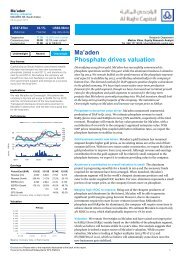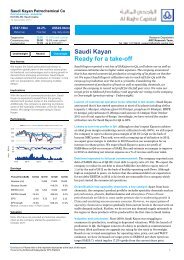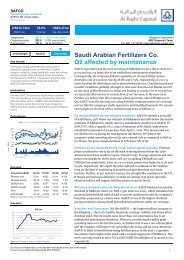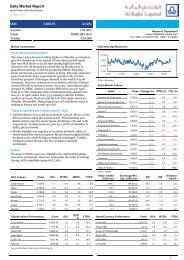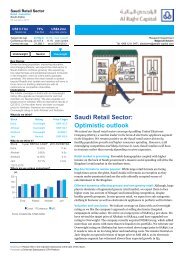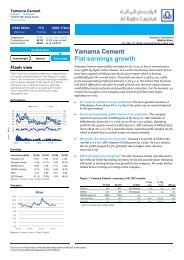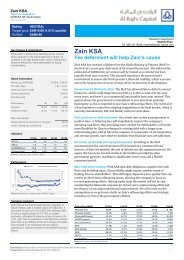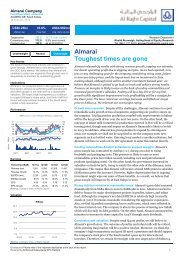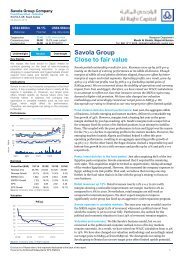Executive Summary - Al Rajhi Capital - الراجØÙŠ الماليه
Executive Summary - Al Rajhi Capital - الراجØÙŠ الماليه
Executive Summary - Al Rajhi Capital - الراجØÙŠ الماليه
Create successful ePaper yourself
Turn your PDF publications into a flip-book with our unique Google optimized e-Paper software.
Banks & Financial Services<br />
Notwithstanding an increase in provisions for bad loans,<br />
the financial results of the Banking sector showed growth in<br />
third quarter profits of 1% to SR 6.14 billion compared with<br />
the corresponding quarter of the previous year, thanks to the<br />
rise in income from basic operations and higher returns on<br />
commissions. Six banks reported growth in their net income,<br />
while four banks reported declines of varying degrees due to<br />
the rise in the provisions for bad loans. The Saudi Investment<br />
Bank ranked first on the gainers list as it achieved the highest<br />
growth rate of above 200% amongst all the banks in the third<br />
quarter as a result of achieving high investment returns,<br />
followed by Riyadh Bank with close to 50% growth rate, mainly<br />
attributable to the rise in the operating profits. In contrast, <strong>Al</strong>-<br />
Bilad Bank reported the highest decline in the seasonal profits<br />
with its third quarter profits plunging by about 96% due to the<br />
conservative policy adopted by the Bank and reflected in higher<br />
loan loss provisions. The largest bank, <strong>Al</strong> <strong>Rajhi</strong> Bank, reported<br />
net profit of SR 1.7 billion, constituting 29.2% of the total<br />
sector’s profits. Samba ranked second on 19.0%, followed by<br />
Riyadh Bank on 12.4%.<br />
The sector’s performance for the first nine months showed a<br />
slight decline in profits of 2.6% year-on-year from SR19.4 billion<br />
to SR 18.9 billion, with six banks witnessing declines in their net<br />
profits and only four banks reporting profits. <strong>Al</strong> <strong>Rajhi</strong> Bank led<br />
the gainers list with 4% growth due to higher customers’ deposits<br />
and the diversification of the Bank’s financing and investment<br />
products to both the retail and corporate segments; however,<br />
the Bank maintained its conservative policy by increasing the<br />
financial provisions. Samba grew by 2.7% due to higher profits<br />
from basic operations and growth in the customers’ deposits.<br />
ARNB and Riyadh Banks staged minor growth rates at 1.1% and<br />
0.4% respectively. It is to be mentioned here that <strong>Al</strong>inma Bank<br />
profits were excluded due to non-existence of a comparable period.<br />
The corporate profit announcements have reflected the general<br />
soundness of the Saudi banking sector, which has not been<br />
greatly affected by the financial crises that shook even many of<br />
the strongest global banks. As evidence of this, it is worth noting<br />
that the sector achieved growth in assets of 2.3%, deposits of<br />
7.0 % and loans of 1.6%. It seems reasonably clear that that the<br />
conservative policies adopted by the Saudi banks have guarded<br />
them against the international credit risks. This is evident from<br />
the increase in the credit risks provisions as the listed banks<br />
(with the exception of the Hollandi and <strong>Al</strong>-bilad banks) allocated<br />
about SR 1.5 billion in the third quarter to meet expected credit<br />
losses, with an increase of more than 330% compared with the<br />
provisions appropriated for this same purpose during the same<br />
quarter of the previous year. It is noteworthy, however, that the<br />
Saudi banks have not revealed their precise exposure to the<br />
heavily indebted and struggling Saudi groups Saud and Ahmad<br />
Hamad <strong>Al</strong>gosaibi.






